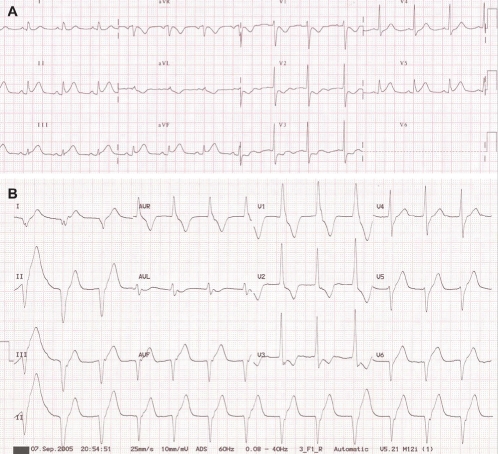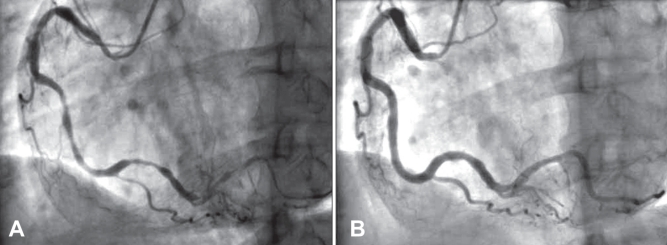Abstract
Prostaglandin E (PGE) is the preferred agent for second-trimester pregnancy termination. Hypotension, bradycardia, ventricular arrhythmias, myocardial infarction, cardiac arrest and death associated with PGE have been reported. A case of acute myocardial infarction due to coronary vasospasm induced by PGE is described in the present report. The diagnosis was confirmed by electrocardiography and coronary angiography.
Keywords: Coronary vasospasm, Myocardial infarction, Prostaglandin
Abstract
La prostaglandine E (PGE) est l’agent favorisé en cas d’interruption de grossesse du deuxième trimestre. On a déclaré des cas d’hypotension, de bradycardie, d’arythmies ventriculaires, d’infarctus du myocarde, d’arrêt cardiaque et de décès associés à la PGE. Le présent rapport expose un cas d’infarctus aigu du myocarde causé par un vasospasme coronaire induit par la PGE. L’électrocardiographie et la coronarographie ont confirmé le diagnostic.
CASE PRESENTATION
In September 2005, a 44-year-old woman was admitted to the hospital for a therapeutic abortion. She was at 18 weeks gestation. She had undergone hemodialysis for five years, and had taken carvedilol, nifedipine and valsartan for hypertension. She had no history of smoking or hormonal replacement therapy. The induction of abortion was attempted using a total of five vaginal prostaglandin E (PGE) pessaries (synthetic PGE1 analogue misoprostol 200 mg, 400 mg and 400 mg) during a 20 h period. On vaginal examination, the cervix was unchanged. Subsequently, she was given intravenous PGE (synthetic PGE2 analogue sulprostone, maximum dose 42 μg/h). Approximately 8 h after administration, she complained of acute left-sided chest pain and nausea. Her blood pressure was 120/80 mmHg. A physical examination produced normal results. An electrocardiogram (ECG) showed a regular sinus rhythm at 82 beats/min. ST elevation was seen in leads II, III and aVF, with reciprocal depression in the anterior leads (Figure 1A). Serum creatine kinase MB isoenzyme (CK-MB) was 2.9 ng/mL (normal less than 5 ng/mL). The patient was diagnosed with acute inferior myocardial infarction. The pain was subsided slightly by administering sublingual nitroglycerin and an ECG indicated an accelerated idioventricular rhythm (Figure 1B).
Figure 1).
Electrocardiograms. A ST elevation in leads II, III and aVF. B Accelerated idioventricular rhythm
A right coronary angiogram showed multiple luminal narrowing lesions (Figure 2A). A total of 400 μg of intracoronary nitroglycerin was administered. Repeat angiography after administration of nitroglycerin revealed a disappearance of the lesions (Figure 2B). Left coronary angiography showed normal findings. An ECG showed complete resolution of ST elevation. The patient was given nitrates, nifedipine and diltiazem. Ten hours after the incident, a fetus with no signs of life was delivered. Within 24 h, CK-MB reached a maximum concentration of 267.5 ng/mL and CK-MB was normalized three days later. She recovered without complications and was discharged. When last seen in July 2008, the patient reported no complaints.
Figure 2).
Right coronary angiogram. A Stenotic lesions at multiple focal sites. B Spasm was reversed after intracoronary nitroglycerin administration
DISCUSSION
Vasospastic (also known as Prinzmetal’s or variant) angina may be associated with acute myocardial infarction and severe cardiac arrhythmias, including ventricular tachycardia and fibrillation, as well as sudden death. Although responses to various vasoconstrictor substances, including catecholamines, serotonin, endothelin, thromboxane A2 and arginine vasopressin, are greater in spastic segments of the coronary arteries, hypersensitivity to vasoconstrictor stimuli also occurs throughout the entire coronary trees in patients with vasospastic angina.
PGE2 and its analogues have been used therapeutically for their stimulant actions on the pregnant uterus for approximately 40 years (1). PGE2 is the preferred agent for second trimester pregnancy termination and severe cardiovascular complications associated with PGE2 are rare. It is also useful for cervical ripening and induction of labour in pregnancies complicated by serious maternal illness. However, hypotension, bradycardia, ventricular arrhythmias, myocardial infarction, cardiac arrest and death associated with PGE2 have been reported. PGE2 is vasodilatory and may also cause coronary artery constriction (2). PGE2 has been suggested as a probable cause of vasospastic angina, and vasospastic angina induced by medical abortion following the administration of prostaglandin has been reported.
Although general actions of PGE2 are well characterized, very little is known about which E prostanoid (EP) receptor subtypes mediate the biological effects of this prostanoid. PGE2 contributes to a wide range of body functions such as the contraction and relaxation of smooth muscle, the dilation and constriction of blood vessels, control of blood pressure, and modulation of inflammation. PGE2 exerts its biological actions via four G protein-coupled receptor subtypes encoded by different genes called EPs (EP1, EP2, EP3 and EP4). All four EP receptors are relevant to the regulation of vascular tone by PGE2. EP1 and EP3 receptors induce vasoconstriction, and EP2 and EP4 receptors mediate vasodilation (3,4). Sulprostone has a selective agonist profile: EP3 > EP1 >> EP2 = EP4 (5). The most probable mechanism underlying potent contractile actions of PGE2 and its analogues is activation of EP1 and/or EP3 receptors.
In the present case, an ECG showed ST elevation and coronary angiography showed spasm that was resolved with the administration of intracoronary nitroglycerin. PGE may not be the panacea for terminating second trimester pregnancy. In any case, PGE should be used with caution in patients receiving vasoactive antihypertensive medications, especially when pre-existing cardiac disease or risk factors are present.
REFERENCES
- 1.Bygdeman M, Kwon SU, Mukherjee T, Wiqvist N. Effect of intravenous infusion of prostaglandin E1 and E2 on motility of the pregnant human uterus. Prostaglandins and related factors 65. Am J Obstet Gynecol. 1968;102:317–26. doi: 10.1016/0002-9378(68)90001-x. [DOI] [PubMed] [Google Scholar]
- 2.Needleman P, Kulkarni PS, Raz A. Coronary tone modulation: Formation and actions of prostaglandins, endoperoxides, and thromboxanes. Science. 1977;195:409–12. doi: 10.1126/science.831285. [DOI] [PubMed] [Google Scholar]
- 3.Schweda F, Klar J, Narumiya S, Nüsing RM, Kurtz A. Stimulation of renin release by prostaglandin E2 is mediated by EP2 and EP4 receptors in mouse kidneys. Am J Physiol Renal Physiol. 2004;287:F427–33. doi: 10.1152/ajprenal.00072.2004. [DOI] [PubMed] [Google Scholar]
- 4.Qian YM, Jones RL, Chan KM, Stock AI, Ho JK. Potent contractile actions of prostanoid EP3-receptor agonists on human isolated pulmonary artery. Br J Pharmacol. 1994;113:369–74. doi: 10.1111/j.1476-5381.1994.tb16997.x. [DOI] [PMC free article] [PubMed] [Google Scholar]
- 5.Coleman RA, Grix SP, Head SA, Louttit JB, Mallett A, Sheldrick RL. A novel inhibitory prostanoid receptor in piglet saphenous vein. Prostaglandins. 1994;47:151–68. doi: 10.1016/0090-6980(94)90084-1. [DOI] [PubMed] [Google Scholar]




